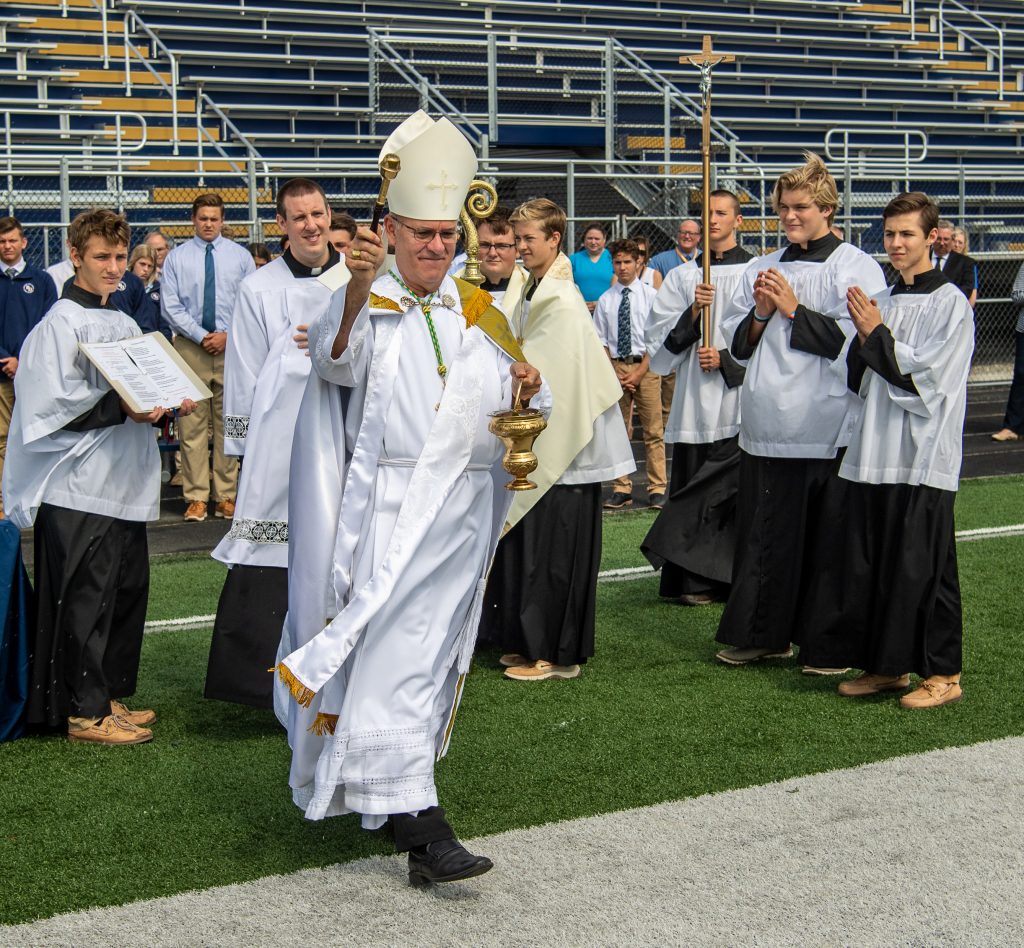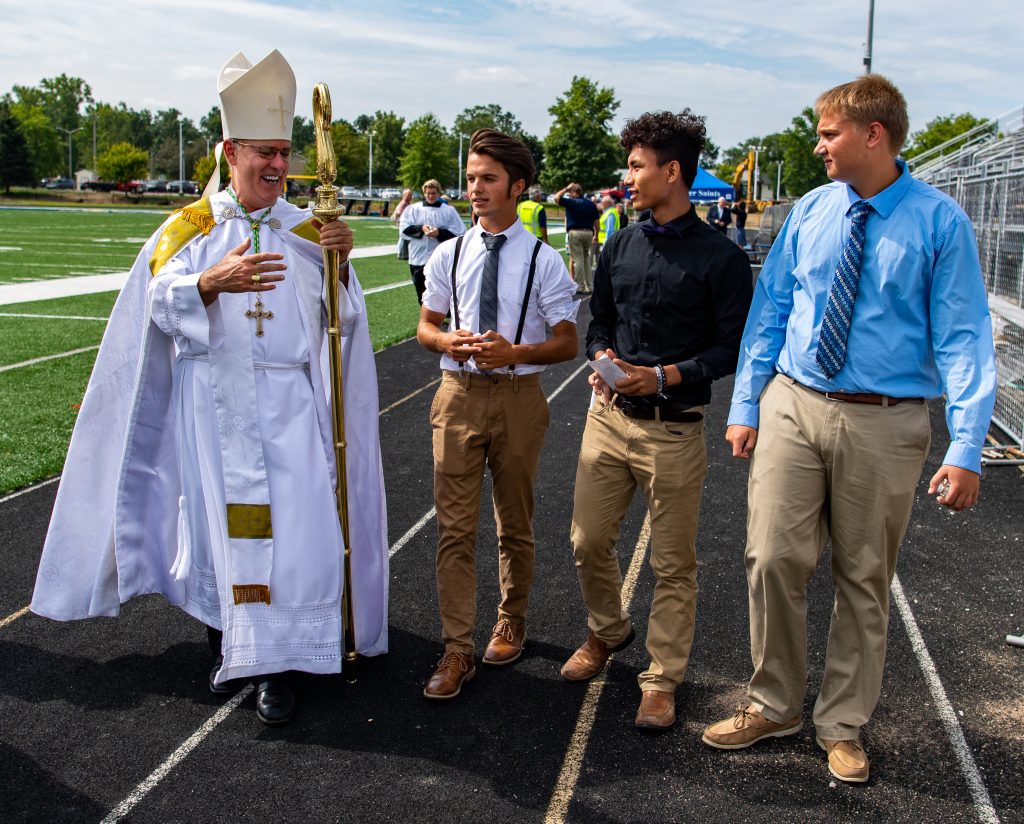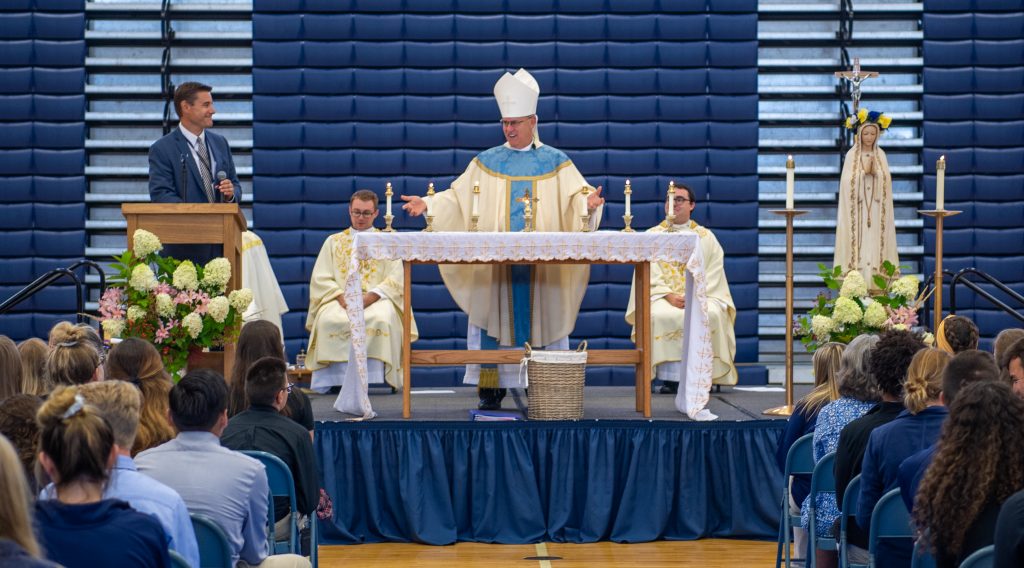August 27, 2019 // Bishop
New stadium, new journey for Bishop Dwenger Saints
Bishop Dwenger High School’s football program marks a milestone Aug. 30: the Saints’ first game in their own stadium. This home game, the second of the 2019-20 season, will be played against North Side.
Throughout the school’s football program history, Bishop Dwenger shared a stadium with fellow Fort Wayne high schools North Side and then Concordia Lutheran. Bishop Dwenger and Concordia shared Zollner Stadium as a home field from the 1980s through the 2018-19 football season.
More photos can be found here.
The reality of Bishop Dwenger being able to have its own home stadium took shape in January, after the school received a generous donation during the holiday season. The donation represented more than one-third of the funding needed to enlarge the school’s current practice location, Shields Field.

After celebrating an all-school Mass at Bishop Dwenger High School, Fort Wayne, Aug. 22, with chaplains and concelebrants Father Jay Horning and Father David Huneck, Bishop Rhoades blesses Shields Field, the schools newly expanded home football field. Around 50 selected students, along with some faculty and representatives from the Tippmann Group and other contributors to the project, joined him. — John Martin
Main features added to Shields Field include a gated entrance and surrounding fence, home and visitor seating, two ticket booths, a press box, restrooms, a concession area and two team rooms. Home seating will hold 2,600 fans and visitor seating will hold 600 fans.
While the stadium will primarily be used for football, it will also host marching band and color guard events and lacrosse, rugby, soccer, track and field, and CYO sporting events.
“This is an awesome venue to celebrate the Bishop Dwenger community and the human spirit through the excitement and festivity of competition,” principal Jason Schiffli said.
Schiffli explained that the new stadium will be a place where “our families come together in a place we call home.” Most importantly, he sees Shields Field as a way “to display the BD spirit and charism by evangelizing our Catholic faith to our guests and modeling the virtues from which we have been graced as a result in practicing and exercising the pillars of our school mission: spirituality, service, academics and living an active life.”
Shields Field is anticipated to strengthen the Bishop Dwenger community. Athletic director John Bennett cited finances as the main reason the school didn’t tackle the project in the past, along with other concerns about logistics such as parking and space on campus.
However, once the donation was received and the decision to build a stadium was made, the process moved quickly. Bennett credited the Tippmann Group, especially Joe Wharton, CME, and Kevin Scully of Design Collaborative for their dedication to the project and how “they pushed the project through.”
Bennett, along with head football coach Jason Garrett, director of maintenance Dan Conroy and director of development and alumni relations Katie Burns, assisted the companies with what was needed and what could be afforded “from everything that went up to the colors.”
While the stadium was under construction, the football team still had workouts and practices on Shields Field. The players and coaches had to navigate the field differently and go through different entrances, Garrett said, but he saw “ongoing and growing excitement” among his team as the project developed.
Senior Luke Wiginton, an offensive lineman, said that “it’s been awesome and exciting seeing the field go up during practices.”
Seeing the stadium go up has been more than exciting for Garrett; the gift has been “a tremendous blessing” for him.
“The new stadium adds new opportunity and a new journey to Bishop Dwenger’s football program,” he said.
He added that for his team, especially the seniors, having this stadium has been very humbling because they understand that there are many players before them “who would’ve done anything to have this opportunity.”
As a part of the new journey with Shields Field, Garrett wants to implement new traditions with his team. One of these new traditions is holding post-game talks on the field after playing a home game. He was able to start this tradition after the team’s scrimmage against Carroll High School on Aug. 16. When the team returned to school after the practice, it was still light outside, so they held their post-game talk on the field. The stadium lights came on for the first time, and along with seeing the reaction from the team it was “a beautiful moment” for Garrett.
There will be many more special moments for the team as they begin playing on Shields Field, especially for senior team captain Griffin Eifert, who plays free safety and wide receiver.
“It’s super special that we’re the first team to walk out on the field, call it ours, and make new traditions,” Eifert said.
Why we call Mary our ‘Queen’
Bishop Kevin C. Rhoades celebrated an all-school Mass at Bishop Dwenger High School, Fort Wayne, on Thursday, Aug. 22, the feast day of the Queenship of the Blessed Virgin Mary. The feast day celebrates the school’s patronage, Mary, Queen of All Saints. The other reason for the bishop’s visit and the liturgy was to bless the school’s new football stadium, Shields Field.
The Gospel read was Luke’s account of the Annunciation. The bishop focused his homily on the passage where Gabriel says, “He will be great and will be called Son of the Most High and the Lord God will give Him the throne of David his father.”
“This Son of the Most High,” meaning Jesus, would become the new king. But not only is Jesus the king of all people but the “king of heaven and earth.”
His reign in the Davidic kingdom as king made Mary the queen. Bishop Rhoades explained that with the Davidic kingdom, the queen was the king’s mother, “not the wife like we might think.” This is seen in the Old Testament with King Solomon and his mother Bathsheba, who was queen. Bathsheba wore a crown and sat on Solomon’s right side and was the second most important person in the kingdom.
This is why we call Mary our queen “because she was the second most important person” in Jesus’ kingship.
But this kingship is a paradox because Jesus’ life was about service and giving His life for His subjects, not domination and power like a typical king. Mary’s queenship is also a paradox because she served as “the humble handmaid of the Lord” and accompanied Jesus to the cross, suffering along with Him.
The bishop then spoke about the Latin phrase “cui servire est regnare” meaning “to reign is to serve.” He said that this phrase “is what Christianity is about” because Jesus and Mary reigned but also served through living self-giving lives. He added that we need to serve like Jesus and Mary did if “we want to be a part of the kingdom” of heaven.
The best news. Delivered to your inbox.
Subscribe to our mailing list today.








